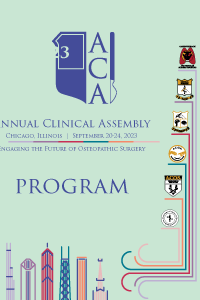General Surgery
Cystic Duct Remnant Syndrome: An Unusual Postoperative Diagnosis
- AH
Alexander S. Hernandez, OMS-III
Edward Via College of Osteopathic Medicine - Louisiana Campus
Lafayette, Louisiana, United States
Primary Presenter(s)
Methods or Case Description:
We present the cases of two individuals who presented with symptoms of abdominal pain, nausea, vomiting and jaundice as a result of a remnant cystic duct. Our first patient was a morbidly obese male with recurrent bouts of gallstone pancreatitis post- partial cholecystectomy. Imaging revealed multiple stones lodged in what was dubbed a remnant gallbladder. Initial intervention included endoscopic retrograde pancreatography for stone visualization and dislodgment as well as stent placement for the time being. The patient was then taken for a second cholecystectomy for removal of the remnant cystic duct. Lastly, the patient was brought in for a final operation for removal of the previously placed stent.
Our second patient presented with cholangitis-like symptoms. This patient also presented post-partial cholecystectomy with primary complaints of fever and abdominal pain. Imaging revealed a remnant gallbladder with stone impaction at the cystic duct and bile duct junction. For treatment we opted for initial retrograde pancreatography during which the remnant cystic duct was cannulated. Then the impacted stone was dislodged along with a wide sphincterotomy to allow for adequate drainage, at which time a stent was also placed. The patient was brought back for a second operation for removal of the previously placed stent and the patient was scheduled for a second cholecystectomy.
Outcomes: The presented cases of two patients with this remnant gallbladder syndrome underwent similar interventions beginning with endoscopic retrograde pancreatography after gallstone visualization on imaging. Additional interventions included stent placement, cystic duct remnant removal, and stent removal as a final step. Both patients had complete resolution of their presenting symptoms.
Conclusion: Cystic duct remnant syndrome is a rare occurrence but has increasing incidence with multiple case reports of such a diagnosis post-partial cholecystectomy. The reported cases discuss laparoscopic versus robotic versus endoscopic approaches for resolution of patients’ symptoms. In the case of our patient’s we utilized both laparoscopic and endoscopic approaches for treatment. With that, there are currently no clear guidelines or best management practices for this up-and-coming post-operative diagnosis. At present, symptom relief is tailor-made to each presentation depending on the presence of stones, body mass index of the patient, and symptoms upon presentation. Our presented cases demonstrate the efficacy of a combination of endoscopic and laparoscopic approaches for cystic duct remnant syndrome symptom resolution.

